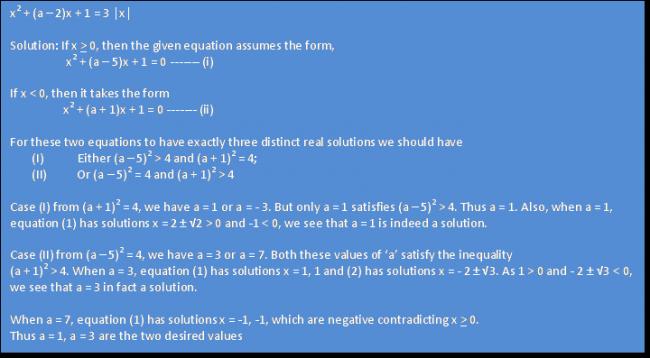 21
21@ rahul when x>0 both the roots of x2-3x+1 = (2-a)x has to be greater than zero
when x<0 roots of x2+3x+1 = (2-a)x has to be less than zero
among the above 4 inequalities ,we hav to find such values of a ,that satisfy only 3 of them
this was my logic...
 341
341Your answer is fine. Jagdish made a mistake in calculation, he should be getting the same numbers as you.
 21
21sir, is my process for qstn 3 correct? is there any other values??
 21
21wow!!! thnx alot sir...its always exciting to knw such new things.......
 341
341If you know Lucas theorem, this is a straightforward application. The form in which it is useful here is this: If p is a prime and n = ap+b and m = cp+d then
\binom{n}{m} \equiv \binom{a}{c} \binom{b}{d} \pmod p
Let n = 7a+b. Also c=1 and d=0. Then
\binom{n}{7} \equiv \binom{a}{1} \binom{b}{0} = a \pmod p......1
Also,
\left[\frac{n}{7} \right] = a \pmod p.......2
The result follows.
 21
21smone pls try the 2nd one...
 36
36Now in the above solution i just can't understand the two cases.....!
Can someone make me understand that....!
 36
36this is rmo 2003 question and the right answer to it is
a = 1 and a = 3
The solution goes this way:

i copied it from there... maybe its a bit blurred so simply try to understand that...
 21
21i got two solution for the third one.....pls check it out///
 21
21yeah...got it n thx
btw can u tell me what is meant by the following expression
x=min{a,b,c}
 36
36can anyone post the solution of the first one!!!!!
 1708
1708for (1) We can draw The Graph of |x|^2-3|x|+1 = (2-a)x
 1708
1708Here b and c are Integer then x must be integer so We can write (x+a)(x+1991) = -1.
Here a must be an Integer so in R.H.S is a Product of 2 Integer.So -1 = -1*1 OR -1 = 1*-1 are 2 possiblaties.
 21
21@man can u pls explain ur logic?/ also try 1st and 2nd
 21
21@ man 111 i got the same answers...i did it like that.. discriminant of (x+a)(x+1991)+1 has to be a square one..which gives (1991-a)2 - 4 has to be a perfect square
from that we can write (1991-a)2 = k2 + 4
now k2+4 has to be a square of an integer..
so,k2+4 = p2
so (p+k)(p-k)=4 or p+k=2,p-k=2 or k=0 or a= 1989 or 1993
other possibilities dont give positive integer solution in k... so a=1989 or 1993
 36
36How do u ppl solve these questions?.....................
 1708
1708$\boldsymbol{Ans:}$(3)\Rightarrow$ $(x+a).(x+1991)+1=0\Leftrightarrow (x+a).(x+1991)=-1$\\\\ Means $(x+a).(x+1991)=-1\times1$ OR $(x+a).(x+1991)=1\times -1$\\\\ From First We Get $x+a=-1$ and $x+1991=1$, From Here We Get\\\\ $x=-1990$ and $\boxed{a=1989}$\\\\ Similarly from $2^{nd}$ We Get , $x+a=1$ and $x+1991=-1$, From Here\\\\ We Get $x=-1992$ and $\boxed{a=1991}$
